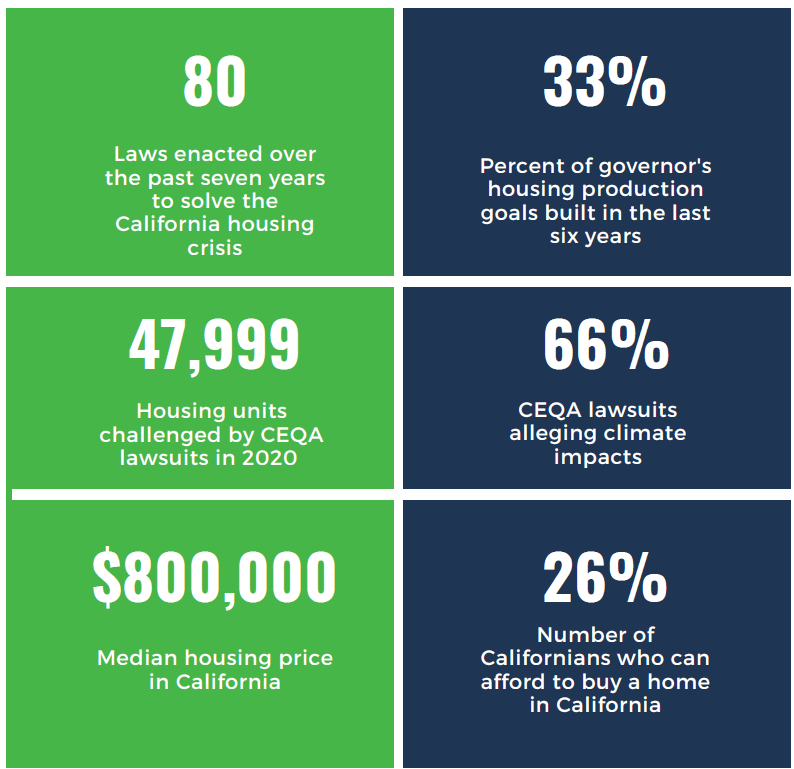Fact Sheet
As part of its ongoing mission to identify and analyze policies driving up the cost of living and impacting the state’s business climate, the Center for Jobs and the Economy is pleased to present this special report, authored by Jennifer Hernandez, attorney and expert in environmental law, housing and land use litigation who leads Holland & Knight’s West Coast Land Use and Environmental Group.
Key Findings
Nearly Half of New Housing Units in 2020 Were Targets of CEQA Lawsuits
- California has built an average of 110,784 homes per year for the past six years, only about one-third of the governor’s housing production target.
- With reduced supply, housing affordability has become worse. Residential racial segregation in the progressive Bay Area is worse than it was in 1968.
- CEQA lawsuits targeting new housing continue to expand. In 2020 alone, there were 47,999 housing units targeted in CEQA lawsuits.
Thousands More Units Affected by CEQA Lawsuits Targeted Upzoning of Existing Neighborhoods
- A 2018 study published by the Hastings Law School Environmental Law Journal found that the most frequently targeted housing projects were higher density housing (e.g. apartments) in infill locations in wealthier communities.
- This report finds that almost 50,000 housing units were challenged by anti-housing CEQA lawsuits, and thousands more were blocked in CEQA lawsuits challenging upzoning in communities to allow more housing, including near transit.
Two-Thirds of CEQA Lawsuits Allege Violation of Climate Impacts
- According to a 2015 study, housing was by far the most frequent private sector target of CEQA lawsuits.
- There has been an explosion of anti-housing CEQA lawsuits alleging failure to properly analyze and/or mitigate two climate-related CEQA impacts: greenhouse gas emissions from project activities and vehicle miles traveled (VMT) from passenger vehicles–regardless of the fuel type (including electric vehicles).
- Only 13% of lawsuits were filed by environmental organizations that existed prior to filling their CEQA lawsuit.
Volume of CEQA Lawsuits Challenging Renewable Energy Exploded in 2020
- Solar, wind, hydropower, water (including management of existing water facilities), flood, and wildfire management projects were all targeted by litigants seeking to preserve the status quo or leverage CEQA lawsuits for other purposes.
The 2022 Air Resources Board Scoping Plan Will Lead to More CEQA Abuse
- Neither the California Air Resources Board (CARB) nor the Office of Planning and Research has created clear, feasible, or lawful standards for how new housing or infrastructure is supposed to mitigate greenhouse gas or VMT impacts under CEQA.
- The CARB 2022 Scoping Plan, by implication and omission, invites more CEQA lawsuits against any type of housing that falls outside a limited number of housing types, all of which are infeasible, expensive, and frequently the target of CEQA lawsuits.
- The CARB 2022 Scoping Plan “Natural and Working Lands” chapter calls for the immediate cessation of new housing and other development on lands not previously developed–not even the buildout of existing cities and projects.
- CARB expressly declined to comply with a legislative mandate (AB 197, Garcia), which requires the Board to analyze the equity, cost, and effectiveness of each Scoping Plan measure.
Using CEQA lawsuits to block housing continues to make housing too scarce and too expensive. California’s working families continue to fall victim to CEQA lawsuits filed “in the name of the environment.”
BY THE NUMBERS


